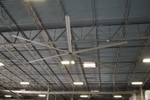
HVLS Fans Beat the Heat
Freeman Audio Visual's operations manager found a six-blade fan worked better for its Dallas distribution center, where the summer heat can make workers uncomfortable.
Today's technologically heavy expos and conventions require a lot of state-of-the-art equipment, and that equipment needs to come from somewhere. That's where the people of Freeman Audio Visual come in. Whether the event requires a simple setup or a multitude of 103-inch plasma screens, Freeman is able to handle the most elaborate setup imaginable. A large amount of its audio and visual equipment is housed in an 85,000-square-foot distribution center located in Dallas.
Because of the nature of their product, Freeman's operation is very hands-on and requires multiple quality control checks. "This is a different distribution center. Everything needs to be loaded and unloaded in a certain way, or the equipment won't work," noted Operations Manager Bill Carmickle. This means the distribution center is full of workers. Between the people and the equipment, it can get very hot in there, especially during a sweltering Texas summer.
A few years ago, Freeman decided to add a High Volume Low Speed (HVLS) fan to the center to help regulate the temperature and keep workers comfortable. When the time came to add more fans to the warehouse, Carmickle did some additional research and visited Serco's manufacturing facility in Carrollton, Texas to see how its HVLS fan measured up. After demonstrating the fan's effectiveness using smoke testing and airflow analysis, Carmickle was able to see for himself the science behind the design.
He knew it would outperform other fans in his warehouse but had to convince upper managers. Carmickle showed them the data, emphasizing that the fan moved more air using less electricity than the one they currently had. They decided to install two -- one on either side of their existing fan.
This new fan was designed to produce a large column of air that flows down to the floor and outward in all directions, creating a deep "horizontal floor jet" that ultimately circulates air up vertically and gets drawn back through the top of the fan. This effectively circulates the air in large areas, keeping workers cool while using minimal electrical draw. The fan breaks the moisture barrier on a worker's skin, reducing the perceived temperature by eight to 10 degrees. This is especially important in an environment such as Texas, where record-breaking heat can drastically reduce productivity in warehouses. According to Carmickle, the HVLS fans "help keep the guys cooler and help keep us working longer into the heat."
Once the fan was installed, workers at Freeman noticed a big difference right away, and Carmickle said "it felt like it was easily pushing 30 percent more air than our original fan." Having the two types of HVLS fan side by side in the same facility enabled Freeman officials to see the difference in air movement for themselves. "With the other fan, when we get in, it goes automatically up to max speed and we wish it would move a little more air," Carmickle said, adding that the newer fan "is almost never operating at max speed, and it moves plenty of air."
The slow movement of the fan keeps the air moving without causing excessive noise or wind. "Basically, if you don't notice it, it's doing its job. The guys have less-sweatier t-shirts at the end of the day, so you know it's working, but you don't realize it as you're doing your job throughout the day," he explained.
Productivity Gains
In addition to the airflow benefits of installing HVLS fans, the team at Freeman has been able to increase their productivity on the floor through the removal of extra clutter. They were able to get rid of three large drum fans that took up precious floor space in their distribution center, giving them more room to maneuver with their fragile products.
Because the HVLS fans cover a large amount of square feet, the need for additional fans and cooling products is reduced. One HVLS fan can circulate air in as much as 30,000 square feet of space. The column of air it produces turns into a horizontal floor jet that is large enough to wash over employees and other ground obstructions.
Installation costs also were lower -- about 50 percent less for the electrical contractor. "The fact that it's one continuous run from the power to the control box to the fan itself saved us a lot of money on installation," and the six-blade design was easier to install than the previous, 10-blade fan had been, said Carmickle.